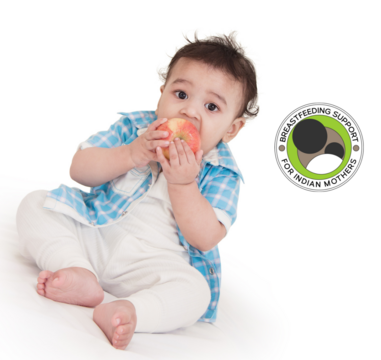When and How can I introduce solids to my breastfed baby?
Introducing solids is a big milestone in a baby’s life and even in her breastfeeding journey. Let’s address the different aspects of introducing solids individually viz. When, how, how much, how often, what and what not etc. with relation to breastfeeding.
The leading health organizations of the world including WHO, Unicef, American Academy of Paediatrics (AAP) and Indian Academy of Paediatrics (IAP) recommend that solids should be introduced to an infant after she completes 6 months i.s. 180 days of life. The readiness for consuming solids is also achieved at about the same time. The main prerequisites are as follows –
- Baby is 180 days old
- Baby can sit unsupported in tripod position for a few seconds
- Baby has lost tongue thrust (the reflex to push everything out of the mouth)
- Baby shows interest in solids
One perspective suggests that solids can be started at the completion of 4 months. However, there are many advantages to delay solids not only for exclusively breastfed babies but also, combi-fed and/or formula-fed babies. Introducing solids too early can increase the risk of respiratory illnesses, weight loss in infancy, obesity in adulthood, food allergies, digestive problems, iron deficiency to name a few.
When to offer?
Breast milk remains the main source of nutrition for the baby until the baby is 1 year old. This is exactly why solids, up to that point, are called complementary feeding. Therefore, solids should not replace breastfeeding sessions until the baby turns 1 year old. So, whenever the baby shows hunger cues, the baby should always be nursed first. Nursing on demand must continue as usual until at least 1 year of age.
Solids are best offered 30-45 minutes after a breastfeeding session. This time gap is ideal to take care of two very important things.
- Baby is not so hungry that she will gobble up a lot of solids which can potentially interfere with breast milk consumption.
- Baby is hungry enough to try out new things as opposed to being too full to have anything.
When solids are introduced, it is recommended to offer only once in a day. Once the baby completes 7 months, another meal can be offered. After one more month or so, a snack can be introduced. By the time the baby is 12 months old, 5 offerings of solids can be incorporated in the daily schedule. 3 meals (breakfast, lunch, dinner) and 2 snacks.
How to offer?
There are two very distinct ways to introduce solids.
- Traditional weaning – This includes the traditional methods of introducing food to the baby which involves feeding the baby in the beginning.
- Baby-led weaning – This approach emphasizes only offering the food to the baby and letting the baby explore the food and eat if and when she wants to, all by herself. This approach encourages self-feeding right from day one.
It is recommended to offer solids to the baby during family mealtimes. This has a positive impact on the baby and builds inclination towards the food.
Finger foods should be incorporated in the baby’s food by the 8th month. This helps develop the pincer grasp and also promotes self-feeding.
What to offer?
Babies should be offered fresh, home-made, healthy food. It is ideal to offer family food to the baby rather than cooking separately. In the very beginning, the food can be mashed a bit with hands/spoons for the baby’s convenience. The consistency should not be runny and/or watery.
- Working knowledge of a balanced diet helps a lot in offering a variety of food from different food groups such as –
- Grains: wheat, rice etc.
- Pulses: types of daal and other pulses, seeds and nuts.
- Vegetables and fruits: these include a wide array of vegetables and fruits.
- Dairy: milk and milk products like curd, butter, paneer, ghee, cheese etc.
- Eggs, fish and meat: these include animal products.
- Iron-rich food: all leafy Sabzis like methi, palak etc, and dates.
- Vitamin C: lemon, oranges, gooseberry (amla) etc.
Along with the above, receiving Vitamin D from sunlight is essential as well.
Babies also prefer variation in colour, shape and texture of the food.
How much to offer?
There is no defined quantity of food that a baby might need or must eat. In fact, each baby is different and has unique eating styles and capacities. The baby must be encouraged to follow her own instinct and should be facilitated to determine what and how much to eat. Babies have an inherent instinct abou when they are full. Expecting them to eat a particular amount of food goes against their natural instinct, which is not recommended. Baby’s decision about what and how much to eat should be respected.
How to offer common allergens?
Nuts, dairy, eggs, soy, wheat etc are common allergens. Latest research has shown that the earlier these allergens are introduced, the lesser are the chances for the allergies to occur. Thus, they are okay to be given to the baby right from the beginning. However, certain precautions need to be taken. E,g, Each nut should be offered separately, eggs should not be undercooked.
What food to avoid?
- Commercial, ready to eat, packaged baby food
- Animal milk as a drink
- Thin/watered down purees
- Fruit juices and soups (whole fruits and vegetables are way more nutritious)
- Sugar, honey, jaggery (for at least the first year of life)
Some resources advise against including salt in the baby’s food. However, considering the amount of food a baby might eat and the usual salt that is included in family food, BSIM suggests taking an individual call about it as in lots of families, the salt included in food does not exceed the recommended upper limit of daily salt consumption. In such cases, babies can be offered food with salt.
Choking Hazards:
Nuts and small fruits can be serious choking hazards. It is very important to offer these only under vigilant supervision. Small fruits like grapes, strawberries should be cut vertically and offered. Nuts can also be cut into slices and offered.
What not to do?
- Force-feeding: Baby should not be forced to eat or finish her food. Force-feeding can ruin a child’s relationship with food. The baby must be encouraged to instinctively control her appetite.
- Distraction feeding: Showing screen (TV/Phone/Tablets), singing, storytelling, showing animals/birds from outside the window, feeding in balcony/terrace, making aeroplane action with spoon etc all account for distraction feeding and are not recommended.
- Keeping baby in reclining position: This is not recommended. When offering solids, the baby should always be in a sitting position.
- Giving too much water: Breast milk takes care of baby’s hydration. Water should only be given at the end of the meal for maintaining oral hygiene. A breastfed baby should be given no more than 40 ml of water a day until she turns 1 year old. A couple of sips after every offering of solids suffices.
- Giving calcium and iron-rich foods together – It can hinder the absorption of iron, its recommended to offer them in separate meals.
- Leave the baby unsupervised – The baby should always be under careful adult supervision while being offered solids. This is important from the perspective of safety.
Breastfeeding after introduction to Solids
6 months to 1 year –
As mentioned earlier, breast milk remains the main source of nutrition for the baby until the baby is 1 year old. This is exactly why solids, up to that point, are called complementary feeding. Therefore, solids should not replace breastfeeding sessions until the baby turns 1 year old. So, whenever the baby shows hunger cues, the baby should always be nursed first. Nursing on demand must continue as usual until at least 1 year of age.
1 year to 2 years –
Breast milk remains a very important part of a child’s diet even after the completion of 1 year. Research suggests that breast milk meets up to 40% calorie requirement of the child even in the 2nd year of life. Breast milk also has a larger fat content as compared to complementary food. Hence, breast milk is a richer source of fats and energy.
2 years and beyond –
According to WHO guidelines, a baby must be breastfed for a minimum of 2 yeast and beyond. Thus, breastfeeding can continue for as long as the mother and the child are comfortable. Breastfeeding does not interfere with the consumption of solids. In fact, it can be very helpful as during illnesses, many children have a drop in appetite and prefer breastfeeding much more over food. In such times, breastfeeding ensures that the baby gets the necessary nutrients and hydration along with antibodies.
References and further reads :
https://kellymom.com/nutrition/starting-solids/solids-how/
https://www.llli.org/breastfeeding-info/starting-solids/
https://www.breastfeeding.asn.au/bf-info/weaning-and-introducing-solids/solidsconfusion

Wish to speak with a member of our team who is a certified lactation professional and also an experienced breastfeeding mother, click on this link.
Medical Advice Disclaimer
THIS WEBSITE DOES NOT PROVIDE MEDICAL ADVICE.
The information, including but not limited to, text, graphics, images and other material contained on this website are for informational purposes only. No material on this site is intended to be a substitute for professional medical advice, diagnosis or treatment. Always seek the advice of your physician or other qualified health care provider with any questions you may have regarding a medical condition or treatment before undertaking a new health care regimen, and never disregard professional medical advice or delay in seeking it because of something you have read on this website.
Disclaimer
We understand and acknowledge that parents and babies can be of various genders on a spectrum of LGBTQI+. Families come in diverse flavours. However, in our articles, for the sake of simplicity and convenience, we will be referring to the breastfeeding parent as the mother and using the female pronouns- ‘she’ and ‘her’ for babies. Babies can be nourished and nurtured in different ways and while we have used the terms breastfeeding and nursing, we recognize that parents can opt to chest feed or finger feed.
We don’t have conflicts of interest and declare, and we are compliant with the WHO code of marketing of breastmilk substitutes and the IMS act.
In case you find any information on this website that needs to be updated, please write to us at info@bsim.org.in






